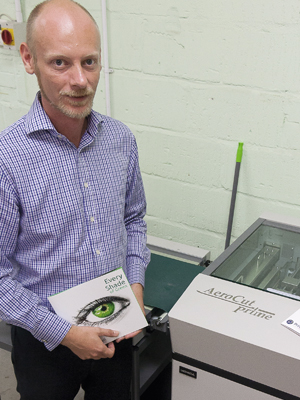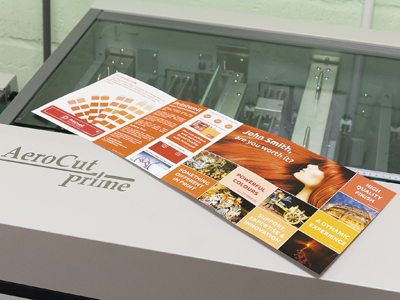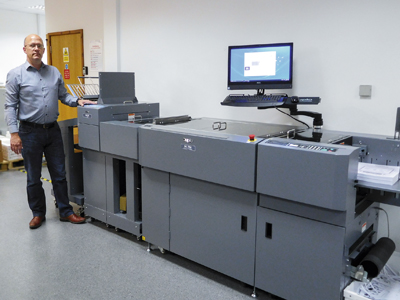BCQ’s Andy Hill appreciates the compactness of the Duplo DC 746
All-in-one finishing units are the ideal complement to the short runs and mixed workload of commercial digital printing, learns Michael Walker.
In pre-digital print days, if you had a litho press banging out tens of thousands of sheets an hour, you needed the bindery to keep up, so you bought creasing, folding, perforating and cutting equipment that could blast through the work at a similar rate. Piles of work in progress had to be shuttled between each finishing station, but once loaded and the parameters set, each would do its thing at a rate of knots and overall productivity was maintained.
Digital print changed all that. By making it feasible to print much shorter runs, in the hundreds of copies or even less, the bindery became the bottleneck. Even though digital presses mostly couldn’t get anywhere near their offset counterparts for throughput on long runs, their lack of set-up or drying time and ability to move swiftly from short-run job to short-run job meant that large numbers of jobs could arrive quickly in the bindery. Here, the set-up time on each station – not to mention the transit time between them – could quickly come to outweigh the benefit of their running speed.
Into this gap came multi-finishers, all-in-one devices that could perform many of the most common finishing tasks via one setup, and produce finished products ready for packing and shipping. They aren’t fast, in terms of the stand-alone equipment they supersede or complement, but they are very flexible: programmability means that frequently repeating job types and parameters can be recalled swiftly without needing a manual set-up each time, and some can read barcodes on incoming sheets to reset themselves automatically, allowing stacks of different jobs to be loaded in and left to run.
The fact that they perform all their operations in a single pass also means that there’s a big time saving on every job, even those that don’t require different settings.
Modular options allow the choice of finishing capabilities to be modified – different creasing or perforating modes, for example, or additional units for more specialised folding, allowing common jobbing items such as menu cards, tri-folds, business cards and tear-off coupons to be handled.
That’s the theory, at least, but does it stack up in real life? Digital Printer spoke to two multi-finisher users to find out.
Solving the bindery bottleneck
BCQ started life as Buckingham Colour Press some 40 years ago in the centre of the town of the same name but now operates its litho, digital print and wide-format division from a purpose-built site nearby.
‘We do everything, from design to doormat,’ explains manufacturing director Andy Hill, saying that the company has customers from the public sector, private firms, direct end-users and the retail sector.
In addition to B2 offset presses, the BCQ digital fleet comprises HP Indigo 5500 and 7600 models and a mono Océ cut-sheet device, complemented by a Scodix enhancement press, providing both short run and variable data print.
When Mr Hill joined BCQ in 2016, the company was putting its small run digital work through its litho binding facility. ‘We do a lot of perforation and folding, with jobs going from perfing cylinder to guillotine to folder,’ he explains. ‘It was creating a bottleneck. We’re into streamlining and this was not cost-effective. We needed to treat our digital print as a stand-alone operation, from print to finish to dispatch.’
BCQ managing director Chris Knowles looked for a solution and came up with the Duplo DC 746 IFS multi-finisher, which ‘ticked all the boxes BCQ need’. The unit included the integrated folding system that Duplo launched earlier in the summer, which was seen as an essential extra to avoid continuing causing problems on the litho finishing side. The arrival of the DC at the beginning of August immediately relieved the bottleneck in B2 production. ‘Within three hours it was up and running,’ reports Mr Hill.
It’s still early days with the Duplo unit at BCQ. Mr Hill says that ‘programming [it] is easy but you do have to learn it,’ though he points out that the unit ships with more than 200 pre-sets and once a new one is created, it can be recalled at the click of a button for repeat work on regular job formats.
He’s happy with the speed (the DC 746 is actually Duplo’s fastest multi-finisher, see panel), saying ‘it’s OK for what we want – we don’t have to watch it and it’s one process instead of several.’
The unit is being used for parallel folds – ‘we rarely cross-fold on digital size sheets,’ explains Mr Hill, and pattern perforating ‘to a degree – for the kind of work we’re doing at the moment, it works very well.’
BCQ is also looking into the barcode reading capability and at the time of writing was some two to three weeks away from trialling it. Mr Hill says that the codes could be added to regularly printed products without having to change impositions, though he can see that making changes would allow for some greater efficiencies around collated output.
Further automation via JDF is under consideration. The technology is already in use in BCQ’s digital department, where it enables data exchange between a Tharstern MIS and Fujifilm XMF workflow, and is being rolled out into the B2 litho with the imminent arrival of a new UV-LE press. There are also plans to add registration marks to litho jobs so that they can be fed through the Duplo unit, as Mr Hill explains that ‘some customers want litho’ even on short runs. Meanwhile, the unit is doing ‘exactly what they said it would do’.
Loving the long sheet
Another printer that has a bit of everything under one roof is Mitcham, Surrey-based Printwell, where two Heidelberg litho presses are complemented by five Xerox digital machines, a Mutoh roll-to-roll wide format printer, an Esko-Königsberg digital cutting table, a Vivid Matrix foiling unit, hand-fed platens, a booklet maker, guillotines and a wire-o binder. The digital fleet includes a Xerox iGen 5, the only one in the south-east with all three extra colours, which commercial manager John Smith says ‘opens up the digital gamut’ to match more spot colours.
The iGen 5 was acquired at the end of 2016 via Xerox reseller Xeretec. The existing finishing capability was only suitable for sheet sizes of up to SRA3, and so couldn’t handle the 650mm “long” sheet supported by the new iGen.
‘Our existing Morgana perforation unit, from the late 80s/early 90s, was robust and sturdy, so we visited the Morgana showroom,’ recalls Mr Smith. At their Milton Keynes site Morgana demonstrated the Uchida AeroCut Prime multi-finisher. ‘The functionality won it – automation, the software package that came with it, vertical and horizontal perforation, crease marks and slitting,’ confirms Mr Smith. The two-direction perforation capability was especially attractive, as previously, producing tear-off vouchers would require hand-feeding printed sheets or running them twice through the existing Morgana unit. ‘The AeroCut allows us to do this on-the-fly, even with “XXL” digital sheets for 6-page A4s or A4 landscape,’ he says.

John Smith at Printwell uses the AeroCut Prime for everything from flyers to short-run books
Printwell does very short run bookbinding for blue-chip customers such as Sotheby’s, Christie’s and De Beers. Mr Smith reports that the long-sheet pages from the iGen – which he says ‘surpass litho quality’ – are run through the AeroCut unit for creasing and are then hand-folded and cased.
‘The AeroCut is so simple to use with the software and templates, my four-year-old nephew could do it,’ enthuses Mr Smith, though he adds, ‘the templates might take five or even 20 minutes to set up but you don’t have to do it again’. The software-driven or manual approaches also suit different types of users, he reports: ‘it caters for the whole spectrum, from teens to those about to retire’.
The previous finishing machine couldn’t handle double-sided laminated jobs so they had to be produced via guillotines. One Printwell client regularly requires two-sided laminated business cards, which was difficult to schedule in, but the AeroCut takes this in its stride.
The “green button” approach of the AeroCut means that Printwell can assign one person to manage both the multi-finisher and the iGen. Like the Duplo unit at BCQ, the multi-finisher can read barcodes to re-programme itself. ‘It takes minutes to reset when a new size or shape is required,’ says Mr Smith; ‘for digital, that saves a lot of time, as the average business card order is only 16 or 17 sheets of paper.’

The AeroCut Prime lets Printwell produce long-sheet applications like this extended colour gamut flyer easily
In addition to the performance of the Uchida unit, Mr Smith says he’s been impressed with Morgana’s support: ‘Morgana still have the ethos that they don’t want downtime for their clients. Our unit has only been down once after its installation and they went back to Milton Keynes and took the spare off their demo machine.’
Multi-finishers – the choice
There’s a surprisingly small choice of multi-finishers; some vendors describe them as cutter-creasers but they typically do more than just cutting and creasing.
Duplo was first into the market and offers several models, from the entry-level DuCreaser 446 to the DC 746 featured here. The Horizon Smartslitter, sold through Intelligent Finishing Systems, offers a very compete range of functions, though it isn’t described by the manufacturer as a multi-finisher. Morgana sells the Uchida AeroCut Nano (for cards only), One and Prime models, the latter two superseding the Classic and Quatro, also available from UMG.
Read the full September issue of Digital Printer here. Subscribe to the magazine for free – register your details here.





